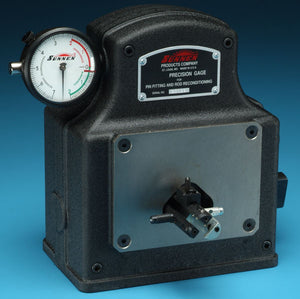Goodson Gazette
Taking the Grind Out of Piston Ring Fitting
We're getting close to the end of our series on Rod & Piston Work. So far we've talked about Connecting Rod Basics, Measuring, Machining and Removing & Installing Pins and Bushings. In this edition of Tech Notes, we'll be looking at Piston Ring Fitting including a video about the Goodson Powered Piston Ring Filer.
The Ins and Outs of Pressing Piston Pins and Bushings
In order to prep your con rods for machining, you will need to have a few items. First, you’ll need a shop press then some fixtures for the press. This Goodson blog post explains the various fixtures available. Get the inside scoop now.Connecting Rod Honing Basics

Inspecting & Measuring the Pistons, Pins & Connecting Rods
Pistons should be inspected and measured at several locations including the skirt, top, middle and bottom ring lands and the pin bore.
The skirt should always be measured exactly 90º from the pin bore. The actual height location may vary from manufacturer to manufacturer, but most specify a location the same height as the pin bore location.
Connecting Rod Basics
Most passenger cars used forged iron or steel connecting rods. They are rigid, light and relatively inexpensive. Rod length, piston diameters and crank pin diameters vary with the application and expected power output. Connecting rods are made in two pieces — a cap and beam section, held together with nuts and bolts.Assembly Lubes Compared
When you start assembling an engine you’re going to be putting metal against metal. To protect that metal, you need some kind of lube. That’s where assembly lubes come in. Assembly lubes are intended to protect the metal from overheating and reduce friction on initial start-up. Sounds easy, right? Wrong. Different surfaces need different types of lubrication and that brings us back to the products that Goodson carries.Valve Springs and what we need to do to make that engine run!
Almost all engines use valve springs to close the intake and exhaust valve during combustion cycles for internal or diesel combustion engines. Keep in mind the cam, pushrods, lifters, and rocker arms do all the work in opening these same valves, but it is the spring that closes and keeps that valve closed during the operation of the engine. These valve springs will be compressed and expanded over and over through their life cycle sometimes at more than 70,000 times in an hour for most high-performance engines, and over its life a valve spring could be compressed million, billions, or even trillion or more times during their life.Valve Lapping 101

Okay, you’ve already cut or ground your valve seats to the correct angles; you’ve ground the valve face in your valve refacer. Are you ready for final assembly of the cylinder head? Maybe, maybe not. The next step in many cases is to lap the valve to the valve seat for a final, perfect fit.
Lapping has been around for as long as engine building has been around. It’s a very simple, straightforward procedure.


